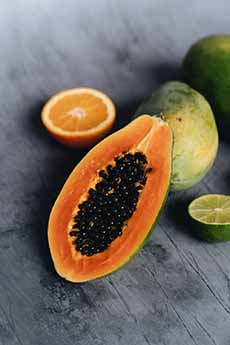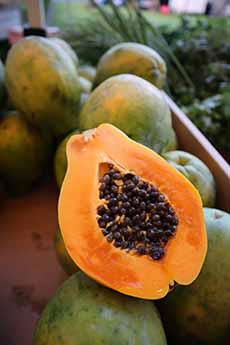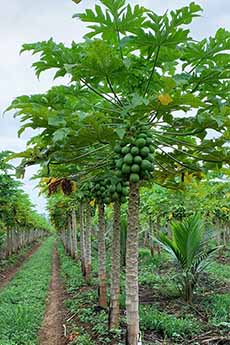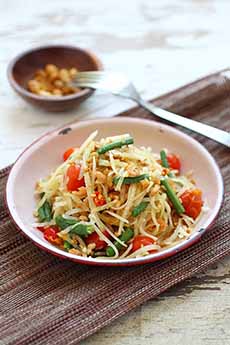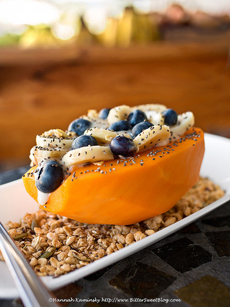Papaya On A Bagel? Plus More Papaya Recipes For National Papaya Month
|
|
September is National Papaya Month and it’s the weekend, so how about something outside the box: papaya on a bagel instead of smoked salmon? Lemon cream cheese brings the right counterpoint so that the papaya is right at home on the bagel of your choice. The recipe, Papaya Ribbons with Lemon Cream Cheese on Toasted Bagels, was created by Southern Selects, a grower of premium products, as a creative way to use its papayas. > The history of cream cheese. > The history of the papaya is below. > There are more delicious papaya recipes below. We didn’t have a ripe avocado when we made this recipe, but we didn’t miss it. 1. CUT the papaya in half, scoop out and discard the seeds. Slice the halves into 4 sections lengthwise. Trim the skin from the flesh. 2. USE a vegetable peeler or a mandolin to thinly slice the papaya flesh into ribbons. 3. CUT the flesh of halved avocado into thin slices. Cut the onion into thin slices and place both on the side. 4. ZEST the lemon with a grater. Combine the lemon zest, cream cheese, and honey. Toast the bagels. When the bagels are ready… 5. SPREAD the cream cheese mixture on one side of the toasted bagel and top with sliced papaya and then avocado. You can add a couple drops of lemon juice on top of the bagel, or serve it with a lemon wedge. Savory Recipes Today, the fruit can be found in a variety of cultures and their foods, ranging from savory to sweet. Note that you can easily substitute papaya for mango in most recipes. The papaya, Carica Papaya L., is believed to have originated in southern Mexico and eastern Central America. Also known as the pawpaw*, the papaya is one of the 22 species in the genus Carica of the family Caricaceae, a family of flowering plants in the order Brassicales. (If that sounds familiar, see footnote †). The name arrives from ababai, a word in the Carib language of South America. It may represent the fusion of two or more species of Carica that are native to Mexico and Central America [source]. The papaya was first domesticated in Mesoamerica, in the area of modern-day southern Mexico and Central America. By the time the Spanish arrived, in 1529, the papaya had already spread throughout Central America and into South America. Spanish invaders greatly enjoyed the salmon-orange-colored fruit and planted it throughout the Caribbean and South America. The Spanish then introduces it to Asia via the Philippines. It spread to India, and eventually to Europe. By the 17th Century, Dutch and Portuguese colonists had brought papaya to Africa and then onto the Far East, where it became an integral part of the cuisines of Southeast Asia [source]. By the 19th century, the fruit was being cultivated in all of the world’s tropical regions [source]. And why not: The succulent fruit, moderately sweet, has those special qualities that say “tropical!” even if you were blindfolded and given a bite. The fruit became popular for breakfast and green salads, pies, not to mention confections, juice, pie, sherbet, and other desserts. You can also toss halves on the grill, or add them to skewers. In 1932, Papaya King, a New York City hot dog stand, was the first to start what became a papaya juice craze. It’s still around, replicated by other mini chains such as Gray’s Papaya and Papaya Dog. In 2020, India produced 43% of the world supply of papayas [source]. Papaya (is the third most cultivated tropical crop worldwide [source]. |
|
|
________________ *Among other names for papaya are mamao, melon zapote, and papayo. But wait: Papaya is also known as papaw in Australia and other parts of the world. However, in the U.S., a pawpaw is not a papaya but an indigenous, mango-shaped fruit. †Brassicaceae (brah-si-KAY-see-ay), a high-antioxidant Brassicaceae family of flowering plants, was formerly called the Cruciferae and is sometimes called the Brassicas. cruciferous vegetables, mustard family, or cabbage family. The vegetables are nutritional powerhouses, packed with potent, cancer-fighting phytonutrients. Members include arugula, bok choy, broccoli, Brussels sprouts, cabbage, cauliflower, collards, horseradish/wasabi, kale, kohlrabi, mizuna, mustard greens, radish, rapeseed/canola, rapini, rutabaga, tatsoi, turnips, and watercress, among others. ‡Carib or Kari’nja is a Cariban language spoken by the Kalina people (Caribs) of South America. It is spoken by around 7,400 people mostly in Venezuela, Guyana, Suriname, French Guiana, and Brazil.
|
||

